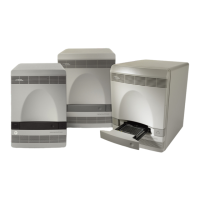DRAFT
September 25, 2007 1:07 am, 4376782_Get_Started.fm
Chapter 1 Get Started
Select an Installation Layout
Applied Biosystems StepOne
™
and StepOnePlus
™
Real-Time PCR Systems
Installation, Networking, and Maintenance Guide
CONFIDENTIAL — For AB Internal Use Only. Do Not Distribute.
10
Notes
Standalone
Layout
In the standalone layout, the instrument is not connected to the computer. Instead, a USB
drive ( ) is used to transfer data between the instrument and the computer. In this
configuration, you set up and analyze experiments from the computer but run them from
the instrument touchscreen. The following figure shows an instrument in a standalone
layout.
Note: Experiment data can be transferred between the standalone instrument and
computer over an Ethernet network ( ) connection. See “Networked Colocated and
Standalone Layouts” below for more information.
The workflow for the standalone layout is more complicated than for the colocated layout
because the system components do not share a direct connection. The following steps
summarize the experiment workflow for a standalone system:
1. Create the experiment on the standalone computer using the StepOne
™
software.
2. Transfer the experiment to the standalone instrument on a USB drive.
3. Start the experiment from the instrument touchscreen.
During the run, monitor the run from the instrument touchscreen.
4. Transfer the experiment to the standalone computer on a USB drive.
5. Analyze the experiment on the standalone computer using the StepOne
™
software.
Networked
Colocated and
Standalone
Layouts
You can expand the functionality of a colocated or standalone instrument by connecting it
to an Ethernet network. When an instrument is part of a network, other computers on the
network that are running the StepOne
™
software can:
• Monitor the status of the instrument
• Send and download experiments to and from the instrument
IMPORTANT! Computers on the network cannot control the instrument, only monitor it.
Note: Chapter 5, “Connect the System to a Network,” on page 73 contains a detailed
explanation of how to install the instrument to a network.
